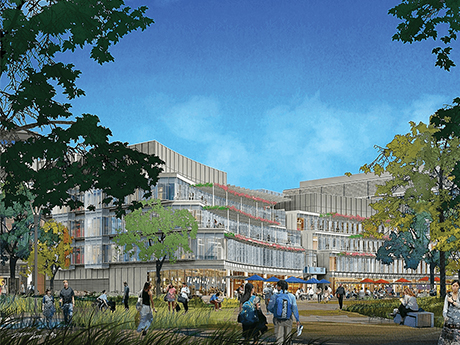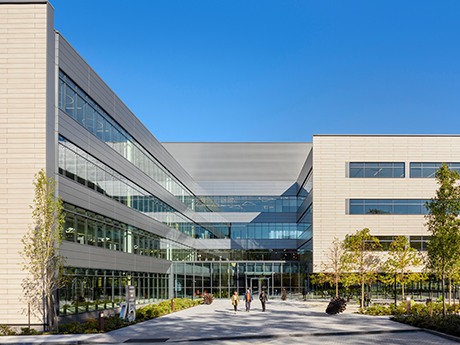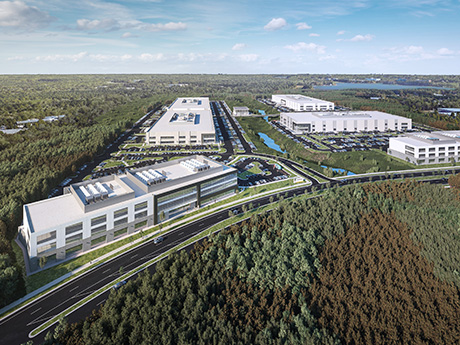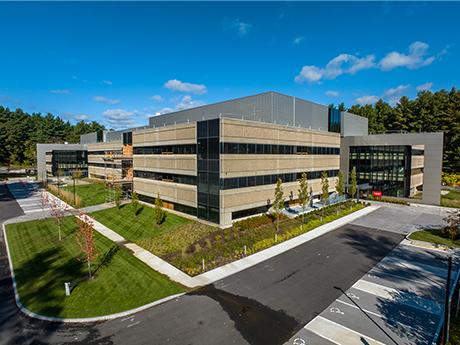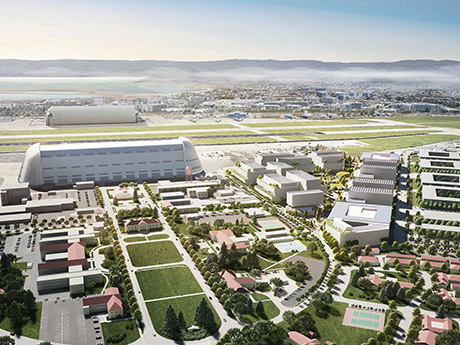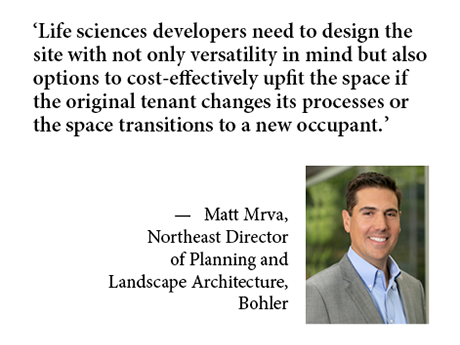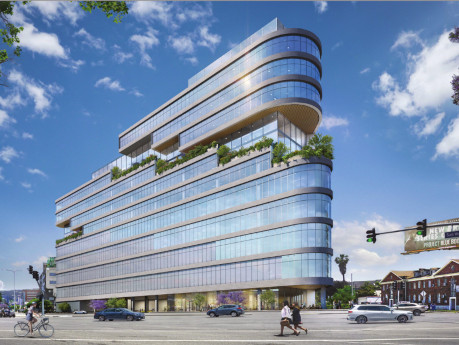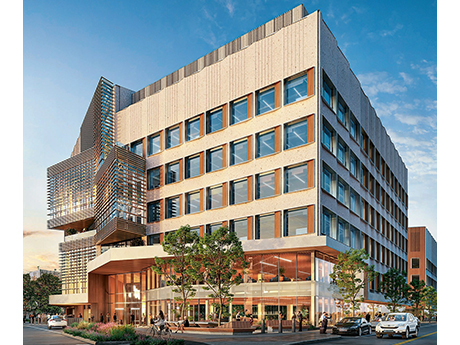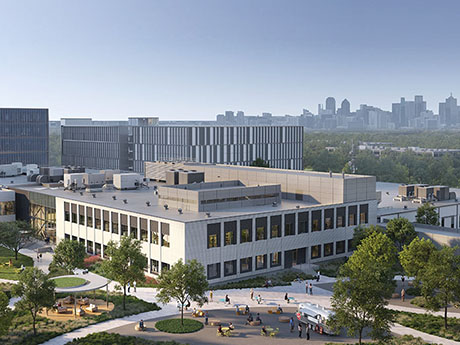HOUSTON — Texas Medical Center, The University of Texas MD Anderson Cancer Center (MD Anderson), Texas A&M University Health Science Center and The University of Texas Health Science Center at Houston have opened the TMC3 Collaborative Building in Houston. The building is the first project completed within Helix Park, a life sciences campus spanning 37 acres and approximately 5 million square feet of planned development. At full build-out, the Helix Park campus will also offer a 700,000-square-foot industry research building called Dynamic One, six future industry and institutional research buildings, a hotel, a residential tower and a mixed-use building with retail space. Helix Park will also include 18.7 acres of green space across six public parks, which will link together in a double helix configuration. Each park will comprise approximately 55,000-square feet. The parks will offer gathering space, water features, cafes, retail shops and other public spaces. Individual gardens will be available as event spaces. The TMC3 Collaborative Building comprises 250,000 square feet at the heart of Helix Park. According to the Texas Medical Center, the property was designed to foster collaboration between academic institutions and industry partners. The building offers purpose-built wet laboratories, as well as office and co-working space. The building will …
Life Sciences
LEXINGTON, MASS. — Voyager Therapeutics has signed a 61,307-square-foot life sciences lease expansion at Hayden Research Campus in Lexington, a northwestern suburb of Boston. The tenant’s footprint now spans 93,449 square feet at the campus, which offers amenities such as a cafeteria, fitness center and outdoor gathering spaces. Jon Varholak, Eric Smith, Perry Beal and Alex Plaisted of CBRE represented Voyager in the lease negotiations.
King Street, BE&K Top Out 200,000 SF Advanced Manufacturing Facility in Morrisville, North Carolina
by John Nelson
MORRISVILLE, N.C. — King Street Properties and BE&K Building Group have topped out the second building in Phase I of Pathway Triangle, an advanced manufacturing campus underway in Morrisville, a western suburb of Raleigh. The 75-acre project will span 1 million square feet of space and represent a total investment north of $1 billion, according to the property website. The first building in Phase I is a 160,000-square-foot building that is set to open this year. The second building will span 200,000 square feet and be delivered in early 2024. Other facilities planned for the first phase include a 140,000-square-foot research-and-development building and an 8,000-square-foot amenity center. CBRE | Raleigh handles the leasing assignment at Pathway Triangle. King Street has a similar campus underway in Devens, Mass., that is home to three tenants and also branded under the Pathway concept.
BEDFORD, MASS. — A partnership between Redgate, Optimum Asset Management and AEW Capital Management has delivered Bedford Labs, a 288,000-square-foot life sciences project located about 20 miles northwest of Boston. The partnership delivered the project fully preleased to biotechnology firm Sarepta Therapeutics, and with the building shell and core completed, the development team is now underway on the interior build-out. Bedford Labs sits on a 52-acre site and includes a 28,000-square-foot amenity space.
UC Berkeley, SKS Partners Unveil Plans for $2B Innovation Hub at NASA Research Park in California
by Katie Sloan
MOUNTAIN VIEW, CALIF. — A joint venture between SKS Partners and the University of California, Berkeley has unveiled plans for a $2 billion innovation hub at NASA’s Ames Research Center in the Silicon Valley city of Mountain View. Plans for the 36-acre development, dubbed Berkeley Space Center, currently include 1.4 million square feet of Class A office and research and development space; wet and dry labs; conference space; academic facilities; retail space; and 18 acres of open green space, including outdoor working yards and a central green for community gatherings, activations and exhibitions. The focus for the development is to provide research space for companies interested in collaborating with the university and NASA scientists to create future innovations in aviation and space exploration. Later phases of the project are set to include short-term stay facilities and student and faculty housing. While the development has not yet received municipal approval, the environmental entitlement process has commenced and is expected to last approximately two years. Construction is tentatively scheduled to begin in 2026. The development team for Berkeley Space Center includes design, architecture and engineering firm HOK and urban design and landscape architecture firm Field Operations. The joint venture has also tapped …
BohlerContent PartnerDevelopmentFeaturesIndustrialLife SciencesMidwestNortheastOfficeSoutheastTexasWestern
Site Design Science: How Understanding Operations Draws Pharmaceutical Manufacturers
Pharmaceutical companies have captured the interest of many developers and with good reason. Softening demand for traditional office space has planners looking for alternative uses to fill out business parks and multiuse developments, and drug makers represent a promising source of highly valuable occupancy. Speculative construction that accelerated during the pandemic has given pharmaceutical manufacturers plenty of options and enabled them to be choosy in site selection. However, to compete for end users, developers must ensure their properties offer the features and amenities drug makers seek, says Matt Mrva, northeast director of planning and landscape architecture at Bohler, a land development consulting and site design firm. “Simply adding a life sciences label on conventional flex space is unlikely to lure pharma companies. Research, lab and pharmaceutical manufacturing facilities often require specialized infrastructure and site layouts,” Mrva says. “Even if a property is zoned to allow for life sciences, design and development teams need to understand the proposed operations in order to optimize the facility.” Unique Facility Requirements Depending on anticipated needs, tenants may require advanced climate control and ventilation, redundant electrical feeds, high-volume water and sewer service, on-site wastewater pretreatment, backup power generation, reinforced floors to handle the weight of …
Stockdale Capital Partners Plans 145,000 SF Medical Office, Life Sciences Project in West Los Angeles
by Amy Works
LOS ANGELES — Stockdale Capital Partners has announced plans for 656 S. Vincente Boulevard, a medical office and life sciences property in Los Angeles’ Golden Triangle area. The project will be the first new medical office and life sciences building constructed in the area in more than 20 years. The 12-story property will feature 145,000 square feet of Class A medical office and life sciences space that combines both environmental sustainability and best-in-class amenities. The building will feature electric vehicle charging stations, ample bicycle parking, direct access to a major transit thoroughfare and 418 parking spaces with full valet service for tenants and patients. The project team includes Atelier R and HMC for architectural and design services. Jones Lang LaSalle’s construction management team will support pre-construction and consulting services through the design and construction phases. The building will include an integrated solar framework capable of offsetting building energy usage; recycled building materials designed to maximize energy efficiency; high-efficiency heating and cooling systems; low-water usage plumbing and mechanical systems; drop irrigation; extensive green space; and interior and exterior gardens to help optimize air quality throughout the building. Core-and-shell completion is slated for October 2026. Angie Weber and Dana Nialsi of CBRE will …
Alexandria Real Estate Equities to Deliver Moderna’s Headquarters in Cambridge, Massachusetts in November
by John Nelson
CAMBRIDGE, MASS. — Alexandria Real Estate Equities Inc. (NYSE: ARE), an office and life sciences REIT based in Pasadena, Calif., plans to open Moderna’s (Nasdaq: MRNA) new global headquarters in Cambridge ahead of schedule. The developer will deliver the 462,100-square-foot property at 325 Binney St. in November. The building will serve as Moderna’s corporate headquarters and also house the company’s core research-and-development operations. The property will be situated within Alexandria Center at the One Kendall Square mega campus, which is located near other life sciences firms and top-tier institutions in the Greater Boston area, including Harvard University and MIT. “We value our longtime strategic relationship with Alexandria. It has been a privilege to work with their team to develop our new headquarters and science center designed to be the most sustainable laboratory building in Cambridge,” says Jamey Mock, chief financial officer of Moderna. Moderna will use the facility to continue to hone and make advances in its mRNA medicines and therapeutics to combat a wide range of diseases, including COVID-19. Alexandria Real Estate Equities is targeting for the new property to achieve LEED Zero Energy, LEED Platinum Core & Shell, Fitwel Life Science and WiredScore Platinum certifications. The property will …
DALLAS — General contractor and construction management firm Swinerton has topped out Bridge Labs at Pegasus Park, a 135,000-square-foot life sciences project in northwest Dallas. The project represents the latest phase of the 23-acre Pegasus Park development. A partnership between Montgomery Street Partners, J. Small Investments and Lyda Hill Philanthropies owns Pegasus Park, the master plan of which also includes an 18-story tower with 538,000 square feet of office space and a brewery/restaurant. Full delivery is slated for the second quarter of 2024. Jim Curtin and Andrew Gray of JLL, along with Jason Piering of Hamilton Realty Finance, arranged financing for the redevelopment that included a five-year construction loan from Interbank and C-Pace financing through Nuveen Green Capital.
DEVENS, MASS. — Colliers has negotiated a 101,000-square-foot life sciences lease at Pathway Devens, a 45-acre campus located about 50 miles northwest of Boston. John Carroll III and Kevin Brawley of Colliers represented the tenant, Ascend Elements, which produces parts for lithium ion batteries, in the lease negotiations. Brian McKenzie and Alex Plaistead of CBRE represented the landlord, Boston-based King Street Properties. The deal brings the first phase of the development to full occupancy.


